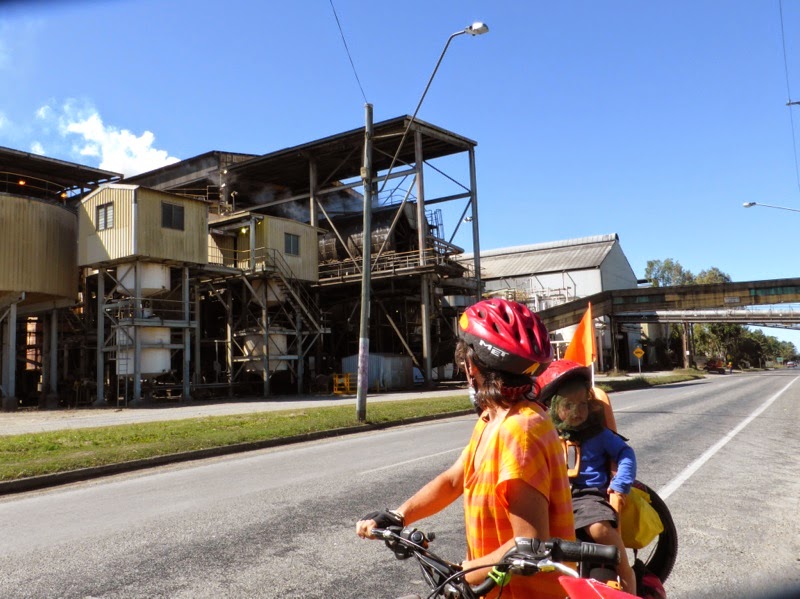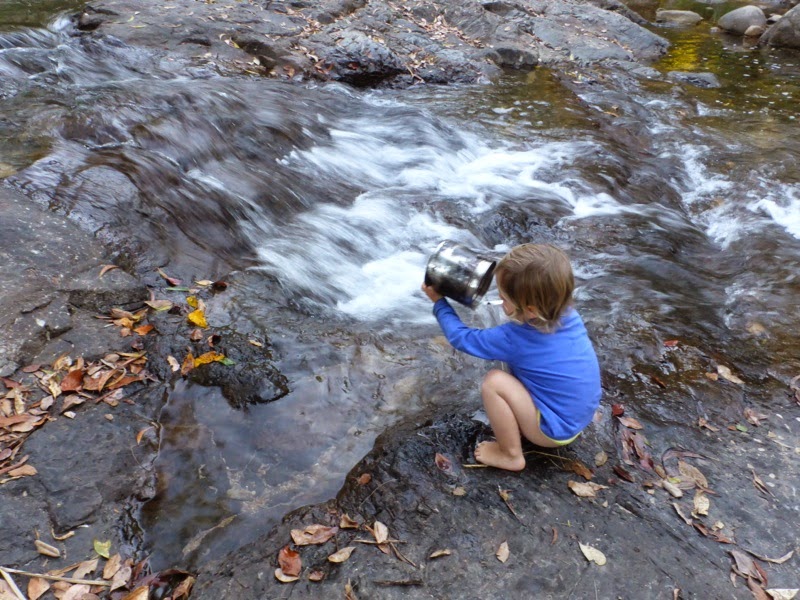We left Mackay and travelled the long but quiet route to Calen, witnessing more ill-effects of the sugar industry.
Dispersed beside the monocultural fields we found plants that have no economic or ecological status, such as these health-giving sow thistles (eat the young tender less bitter leaves),
guava (this is the largest fruit we've seen so far, measuring 80mm in length, and oh so delicious!),
and public citrus. (If you're in the air when you pick private fruit does that make it public??)
We got a bike-eye view of sugar processing, which confirmed our resolve to remain a processed-sugar-free family (which means not purchasing the great majority of supermarket items),
as we travelled along the cane fields,
and beside the cane trains that were busily moving Australia's obesity epidemic around in little carts.
We travelled the Mirani – Mt Ossa Road west of Mackay until we got to Boulder Creek,
where Jeanie and Peppe, our Warm Showers hosts in Mackay, had suggested we camp. We're glad they did. Thanks J and P! The water was pristine and we refilled our bottles with this dynamic, autonomous mountain brew (there's not many places left in Australia where the water hasn't been polluted by conventional agriculture).
We met a bunch of unruly free campers at Boulder Creek, and we shared stories about our respective communities and where we are heading before it was time to take to the road, once again under Queensland's mid-winter sky.
These quiet roads really are a blessing. Our senses are alive with the absence of motorised transport.
Collecting free citrus in the region is also an absolute treat, and there's no shortage.
In this little public park at Calen, just before we returned to the Bruce Highway, we helped ourselves to free oranges, bush lemons and grapefruits, as well as free power, recharging our devices behind the public toilet block while we feasted.
Not far north of Calen we spotted for the first time these cluster figs (Ficus racemosa),
a well-known bush food of northern Australia, which also grows in India and South-east Asia. When ripe they turn soft, orange and then red, and have a similar texture to commercially-grown figs, only less sweet to taste. They were lovely to eat but a week or more ripening time would have produced a better result.
After nearly nine months of cycle touring we have seen hundreds of snakes on the road. All of them dead, until now. This lively black snake went to cross the Road of Death just south of Bloomsbury, then decided against it, possibly after sensing the hysterical vibrations of Zero's barking. Needless to say we quickly tethered Zero, snake bite being a common cause of death for Jack Russells.
Later in the day we passed another couple of road-killed snakes, several birds of prey, a grass owl, countless kangaroos and wallabies and this little quoll.
We took a few side quiet roads into Bloomsbury and discovered this very interesting vine:
the elephant creeper (Argyreia nervosa), aka Hawaiian baby woodrose, Adhoguda, woolly morning glory, elephant climber, elephant ear vine or silver morning glory. This plant may have been introduced by Aborigines on their route from India thousands of years ago, however some botanists believe it is a relative newcomer and an invasive weed. An ancient healing plant, the seeds are said to be psychoactive, producing similar effects as LSD. We just need a baby-sitter for several hours so we can investigate...
We stopped for the night in Bloomsbury, knocking on the principal's door of the local primary school to ask permisssion to camp the night. Sam, the school's delightful principal, whole-heartedly agreed and offered us use of the staff's bathroom and shower. Blessed warm water and a quiet place (after hours) to lay our heads. Thanks Sam!
For all the interrupting death we witnessed the day before on the Bruce, we instead found abundant life living among the sugarcane wastelands the next day, riding towards Proserpine.
Magpie geese eggs are certainly something we'd like to try, but will have to seek permission from local Indigenous elders before we do.
We spotted the magpie geese at Deadman Creek, just south of Proserpine, on the way to Airlie Beach in the Whitsundays,
another painfully beautiful area on the east coast of Australia done over by rampant corporate-bogan tourism,
with absolutely no evidence or recognition of the original culture, the Ngaro people, to be seen anywhere.
It was in Airlie Beach that we met up with community friends from Daylesford, and shared a camping ground site with them. We had four lovely days with Fiona, Tim and their kids Max and Rose, sharing meals, walks into town and along the beach,
and conversations about our respective research. Tim is currently working on the Healing Ground project, a work combining photography and oral history, recording Indigenous massacre sites and stories from around Australia from the descendants of those who suffered. Please support Tim's project if you have a spare $20 or $50, or whatever you can.
Myall Creek Gallery Piece from Tim Burder on Vimeo.
We enjoyed our time with Tim and Fiona's happy tribe, unclipping our heavy panniers to explore the coastline,
went fishing (Well done Max! Catching your first haul of fish, feeding your family and friends at age 9 is no small feat),
and generally took in the sea.
Thanks for reading this little leg. We'll see you in Townsville...
































All the Best From France and have aFantastic & Artistic trip .
ReplyDeleteHey there Nadia and Michele, thanks so much. Much love from Australia.
DeleteAmazing - this is like living my own trip to Cairns all over again. We went through Giro as well - stayed opposite the sugar cane factory, which stank of burned dog turds.
ReplyDeleteI recommend eating the green tree ants lava. It's an interesting experiment. From my book Changing Gears:
"This rest stop was a highlight because I finally got my
revenge on the green tree ants. On the ground near the toilet
block was a nest of brown gum leaves matted together. My
bush tucker field guide explained that Aboriginals ate the
white larvae found inside, pounding them into a paste to
produce a lime-flavoured drink. Using a large stick, I ripped
open the nest, waited for the ants to scatter, and then picked
up about 70 small white larvae, each one the size and shape of
a kidney bean.
I showed them to Sophie. ‘Yuk!’ she said, screwing up her
nose.
But if we could eat raw oysters, why not raw ant larvae?
So I pounded them to a paste and mixed them with water to
create a cloudy liquid that tasted like sweet diluted milk. In
Rockhampton a man had told me you could eat the ants raw
too. He didn’t warn that if you did, they bit your tongue."
Be sure to stay at South Mission Beach when you reach the tropics - it's much quieter and nicer than Mission Beach. You can also kayak to Dunk Island.
Thanks for the update. You guys are an inspiration doing that journey with a young one.
Hey thanks again Greg, great to hear from you. Although Meg read your book before leaving Patrick has intentionally left it for when we return, not wanting to predetermine anything, same goes for Tracks and other Aussie travel books. We look forward to both delving in to (again) Changing Gears when we return and compare notes.
DeleteWe're heading to Palm Island on Thursday by permission of the local council there, which we are very excited about.
Lovely to be in touch.
AaF